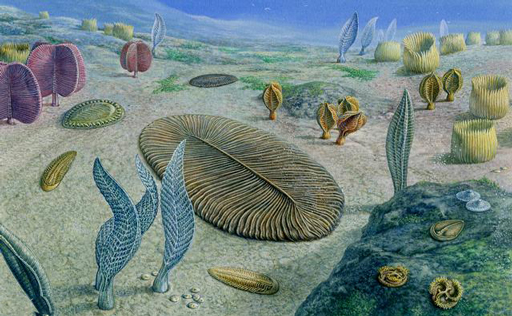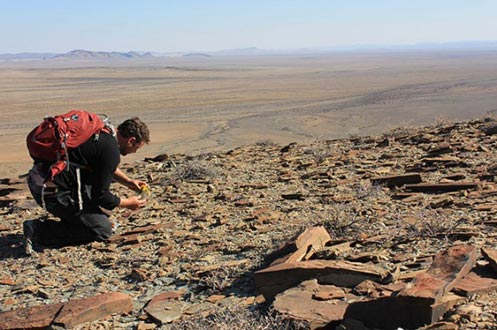World’s First Mass Extinction Engineered by Animals
Ediacaran Faunal Out Competed by Newly Evolved Animals
A remote fossil site in Namibia has helped strengthen the theory that the fauna of the Ediacaran was unable to survive the radical “re-engineering of marine ecosystems” that resulted with the evolution of more advanced biological organisms. Newly evolved metazoans (animals that have three types of tissue layer in the embryo and are multi-cellular), altered the marine environment so much that most of the older, largely immobile, species that had dominated the Ediacaran geological period died out.
Ediacaran Fauna
A Late Precambrian (Ediacaran) Marine Environment
Picture credit: John Sibbick
For models and replicas of ancient invertebrates and other prehistoric animals: CollectA Prehistoric Animal Figures.
The Ediacaran Geological Period
The Ediacaran geological period is defined as the last geological period of the Proterozoic (early life), it lasted from around 635 million years ago to 542 million years ago and this geological period saw the emergence of a diverse variety of soft-bodied multi-cellular creatures, most of which have no living descendants today. The ecosystems that existed were very simple with short food chains, multi-cellular life was bizarre with many organisms shaped like discs, tubes or fronds.
Towards the end the Ediacaran more advanced and crucially mobile organisms began to evolve. Food chains became more complicated with the evolution of active predation amongst organisms. These new species were “ecological engineers” who changed the environment in ways that made it more and more difficult for Ediacaran organisms to survive. That is the conclusion of the research team which studied the Namibian fossil remains.
Assistant Professor Simon Darroch Searching the Namibian Site for Fossils
Picture credit: Sarah Tweedt, Smithsonian Institution
Important Fossil Site
Writing in the journal “Palaeogeography, Palaeoclimatology, Palaeoecology”, the scientists, which include Simon Darroch (Assistant Professor of Earth and Environmental Sciences at Vanderbilt University located at Nashville Tennessee), report that they have found one of the best-preserved examples of a mixed community of Ediacaran and metazoan organisms preserved in strata from the Zaris sub-basin of southern Namibia.
The Biota Replacement Model
Palaeontologists had predicted that evidence would be found in the fossil record to indicate ecosystems dominated by Ediacaran organisms being replaced by ecosystems dominated by organisms whose fossil record persist into the Cambrian and beyond. The Namibian fossils provide the best evidence yet of a close ecological association between these distinct types of life-form.
Assistant Professor Darroch explained:
“Until this, the evidence for an overlapping ecological association between metazoans and soft-bodied Ediacaran organisms was limited. Here, we describe new fossil localities from southern Namibia that preserve soft-bodied Ediacara biota, enigmatic tubular organisms thought to represent metazoans and vertically oriented metazoan trace fossils. Although the precise identity of the trace makers remains elusive, the structures bear several striking similarities with a cone-shaped organism called Conichnus that has been found in the Cambrian period.”
Conichnus Trace Fossils from Namibia – Evidence of Biota Replacement
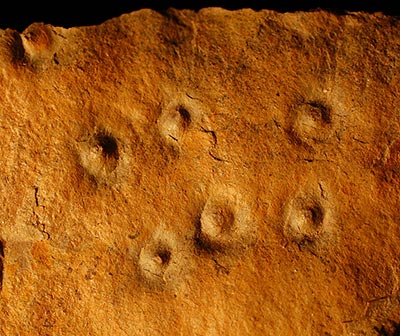
Conichnus burrows are trace fossils. The surface bumps represent vertical tubes that were originally occupied by anemone-like animals that may have fed on Ediacaran larvae.
Picture credit: Vanderbilt University/Darroch
Conichnus is an ichnogenus (known only from trace fossils), that may have been some form of anemone that fed on Ediacaran larvae. The scientists also report that they have found strands of Ediacaran frond-like organisms with animal fossils preserved in place coiled around their holdfasts. The Namibian fossil material provides a snapshot of a transitional ecosystem prior to the Cambrian explosion which led to the evolution of much more modern looking food chains.
Assistant Professor Darroch stated:
“Both animal burrows – ‘trace fossils’ – and the remains of animals themselves sharing the same communities, lets us speculate about how these two very different groups of organisms interacted.”
Lessons for Today
Although the research team are studying the remains of organisms preserved in rocks that were laid down more than 540 million years ago, the biota replacement model that these fossils seem to confirm has relevance for our planet today. Some of the fossil strata shows the preserved body fossils of a bizarre metazoan called Shaanxilithes, these fossils are coiled found the anchoring, trace fossil (a holdfast) of a frond-like organism),
Shaanxilithes Fossils (Ediacaran Strata – Namibia)
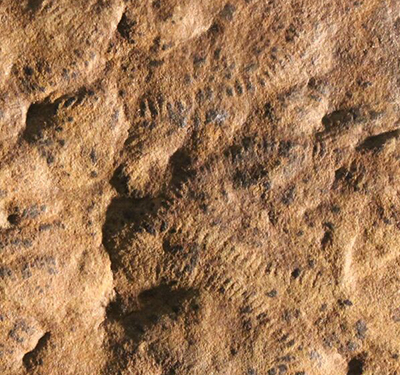
Shaanxilithes are odd, annulated and ribbon-like fossils that start showing up near the end of the Ediacaran period. In this fossil they are wrapped around Aspidella holdfasts.
Picture credit: Vanderbilt University/Darroch
Simon explained:
“There is a powerful analogy between the Earth’s first mass extinction and what is happening today. The end-Ediacaran extinction shows that the evolution of new behaviours can fundamentally change the entire planet, and today we humans are the most powerful ‘ecosystems engineers’ ever known.”
This research entitled: “A mixed Ediacaran-metazoan assemblage from the Zaris sub-basin, Namibia”, builds on an earlier scientific paper published last year that examined a large number of animal burrows preserved in the Namibia rocks that were interpreted as representing the fossil record of a community under stress.
The Disc-Like Structures Represent the Holdfasts of Ediacaran Organisms
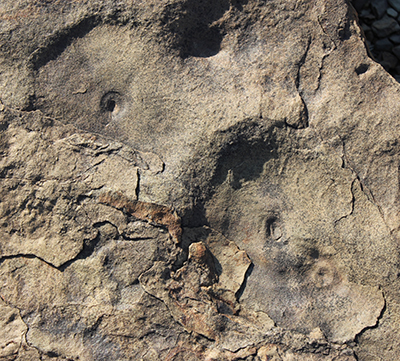
The disc-like fossils are the preserved remains of holdfast structures used by the Ediacaran species Aspidella that went extinct about a million years after these individuals died and were preserved.
Picture credit: Vanderbilt University/Darroch
The picture above shows the preserved remains of several disc-like fossils in the Namibian strata. These have been interpreted as the holdfast, anchoring structures of the fern-like Aspidella. Once thought to be an ancestral jellyfish, at the time it was first studied, it was the first Precambrian body fossil to have been formally scientifically described. These disc shapes are now interpreted as trace fossils, examples of the benthic, immobile fauna of the Ediacaran, that was being replaced by more complex and mobile metazoans.
Stirring Up Sediments
Hunting and eating the Ediacaran fauna might not have been the only destructive behaviour of the more complex mobile organisms that represented emerging fauna that would dominate the Cambrian. The researchers also point out that mobile Cambrian animals would have stirred up nutrients leaving them in suspension above the sea floor, far away from the reach of the benthic Ediacaran life-forms. In essence, the microbial mats and more complex but ultimately, confined to the sea floor Ediacaran fauna, would have found that nutrients that once always fell to the seabed were now suspended in a new marine ecosystem, effectively placing these nutrients out of reach.
Visit Everything Dinosaur’s award-winning website: Everything Dinosaur.


